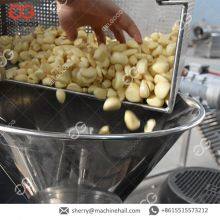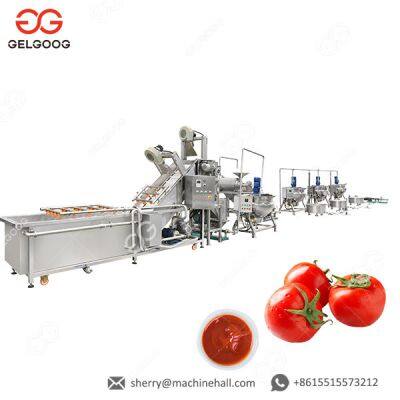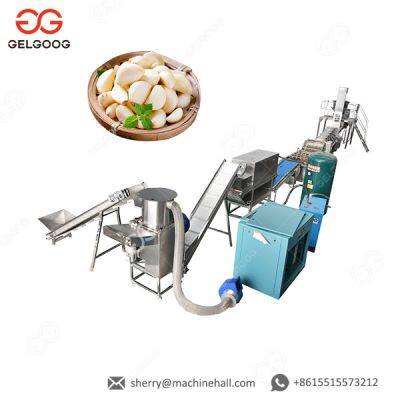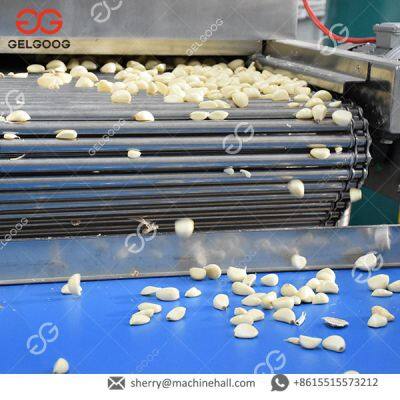Ginger Garlic Paste Making Machine Stainless Garlic Crusher Machine
The ginger and garlic sauce production line is an automated processing line specifically designed for the production of various condiment sauces, suitable for the industrial production of ginger sauce, garlic sauce and various vegetable sauces. This production line is advanced in design and easy to operate. It can effectively improve production efficiency and product quality, and is widely used in food processing plants, deep processing enterprises of agricultural products, condiment manufacturers and other industries.
Introduction to ginger sauce
Ginger paste is a seasoning sauce made mainly from fresh ginger through multiple processes such as cleaning, peeling, grinding into paste, seasoning and sterilization. Ginger is rich in aromatic components and has a pungent taste. It has the therapeutic effects of warming the middle, dispelling cold, stimulating appetite and aiding digestion. It is widely used in pickling, stir-frying, dipping and seasoning, etc. Industrially produced ginger paste should retain the natural flavor of ginger and have good stability and a long shelf life.
2. Introduction to garlic Sauce
Garlic sauce is mainly made from fresh garlic and processed through mechanical peeling, crushing, seasoning, filling and sterilization. Garlic is rich in allicin, which has the functions of killing bacteria, reducing inflammation and enhancing immunity. Garlic sauce is widely used in barbecues, hot pot, mixed noodles, stir-fried dishes, etc. It is an important condiment in the catering industry and home kitchens.
3. Introduction to vegetable Sauce
There are various types of vegetable sauces. Common ones include chili sauce, carrot sauce, tomato sauce, etc. Its raw materials come from a wide range of sources. Different flavors can be formulated according to seasonal raw materials to meet the diverse market demands. Vegetable sauce has a richer flavor presentation. It is usually made by mixing with seasonings such as ginger, garlic, chili peppers, cooking oil and salt, and is both nutritious and delicious.
Garlic sauce production line
Introduction to the main processing flow
The main technological process of the ginger and garlic sauce production line includes the following key steps:
1. Wash and peel
Select different pretreatment equipment according to the types of raw materials:
Fresh ginger: Use a drum cleaning and peeling machine. This equipment is equipped with an efficient cleaning function and a physical peeling device, which can effectively remove the ginger skin and rinse the surface mud, sand and impurities clean.
Garlic: Use a pneumatic garlic clove separator to separate the garlic into cloves, and then use a garlic peeler to quickly peel them to ensure the cloves are intact and the peels are clean.
Other vegetables, such as tomatoes, peppers, carrots, etc., are usually cleaned thoroughly with a brush cleaner or a bubble cleaner to ensure thorough cleaning and minimize damage to the raw materials.
2. Grind the sauce
After cleaning and peeling, the raw materials enter the multi-functional grinding paste for fine grinding. The degree of grinding can be adjusted according to the product requirements. This process is a key link that affects the fineness and taste of the sauce. Some of the equipment is equipped with a double-grinding function to ensure that the sauce particles are uniform, fine and smooth.
3. Mixing and seasoning
Put the ground ginger paste, garlic paste or vegetable paste into the mixing tank, and add an appropriate amount of salt, sugar, oil, soy sauce, spices and other seasonings. During the stirring process, a vacuum state can be set to prevent oxidation and improve the quality and color stability of the sauce. For flavored sauces, ingredients such as black bean sauce, dried shrimp, and mushrooms can also be added to increase the added value of the product.
4. Filling
The seasoned sauce is sent into the automatic filling machine by the high-temperature conveying pump for quantitative filling. Common packaging forms include glass bottles, plastic bottles, flexible packaging, etc. The filling machine can be optionally equipped with capping machines, labeling machines, inkjet printers and other equipment to achieve fully automatic packaging line operations.
5. Sterilization
After filling, the products undergo heat treatment through high-temperature sterilization equipment (such as pasteurization tunnels or steam sterilizers) to effectively sterilize and extend the shelf life. The sterilization parameters (temperature and time) are set according to different product formulas to ensure thorough sterilization without affecting the taste and nutritional components.
Vegetable sauce production line
The vegetable sauce production line is a multi-functional production system specially designed to meet the sauce processing requirements of various vegetable raw materials, featuring extremely strong adaptability and flexibility.
The features are as follows:
Wide range of raw material adaptability: It can be adapted to various raw materials, such as chili peppers, tomatoes, eggplants, carrots, Onions, etc.
Modular design: Equipment can be flexibly combined according to the production needs of customers, such as adding stir-frying POTS, enzyme inactivation devices, fryers, etc.
Strong continuous production capacity: The entire line has a high degree of automation, achieving continuous operation from material input to packaging, making it suitable for medium and large-scale mass production.
Precautions in production
To ensure the quality of the products and food safety, the following points should be noted during the production process:
Raw material freshness control: High-quality raw materials that are free from spoilage and mold should be selected to avoid affecting the flavor and safety of the product.
ginger garlic paste machine
Strict hygiene management: The workshop should implement HACCP management norms, and employees should wear clean work clothes, gloves, masks and other protective equipment.
Temperature and time control: The key steps in sauce processing, such as sterilization, stir-frying, and filling, require precise control of temperature and time to ensure safety and flavor.
Cross-contamination prevention and control: When producing products with different flavors or raw materials, operations should be carried out in different zones or at different time periods to prevent cross-contamination.
Compliance with food additive usage: If preservatives, thickeners, etc. need to be added, they should be used in strict accordance with national food safety standards in terms of proportion.
Precautions for equipment operation
To ensure the normal operation of the equipment and operational safety, the following equipment usage norms should be followed:
Pre-operation inspection: Before starting, check whether all connection parts are tight, whether the power wiring is correct, and whether the pipelines are unobstructed.
Operate in accordance with the process: Strictly follow the operation manual for operation. Do not skip steps or overload the equipment to avoid damage.
Cleaning and disinfection: After the end of each day's production, the equipment should be thoroughly cleaned and regularly disinfected to maintain a hygienic state.
Regular maintenance and servicing: Maintain and replace vulnerable parts such as bearings, sealing rings, and motors at the intervals recommended by the manufacturer to extend the service life of the equipment.

Send Inquiry to This Supplier
You May Also Like
-
Machinery For Ginger Garlic Paste Making Ginger Garlic Paste Making Machine PriceNegotiableMOQ: 1 Set
-
Ginger Grinding Machine Price Electric Ginger Garlic Paste Grinding MachineNegotiableMOQ: 1 Set
-
Industrial Ginger Processing Machine Ginger Garlic Paste Manufacturing MachineNegotiableMOQ: 1 Set
-
Garlic Paste Plant Garlic Sauce Production Line Ginger Garlic Paste Machine PriceNegotiableMOQ: 1 Set
-
Ginger Paste Machine Packing Garlic Paste Manufacturing Plant Garlic Paste Machine PriceNegotiableMOQ: 1 Set
-
Ginger Garlic And Chilly Grining Machine Ginger Garlic Paste Making Machine PriceNegotiableMOQ: 1 Set
-
Super Dried Ginger Grinder Machine /Garlic Ginger And Pepper Grinder Machine/Ginger Gridind MachineNegotiableMOQ: 1 Set
-
Ginger Grinder Machine Ginger Milling Machinery For Ginger Garlic Paste MakingNegotiableMOQ: 1 Set
-
Chili Paste Production Line Chili Sauce Machine Chili Sauce Making MachineNegotiableMOQ: 1 Set
-
Chili Sauce Making Machine Cost Chili Sauce Making Machine For Sale Chili Sauce Making Machine PriceNegotiableMOQ: 1 Set





























